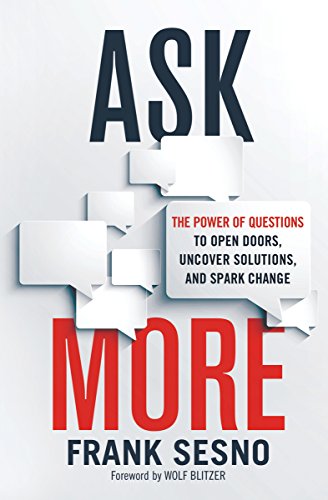
I read Frank Sesno’s Ask More: The Power of Questions to Open Doors, Uncover Solutions, and Spark Change. It was published in early 2017 and I’ve been going through several books that deal with question asking in different ways. I reviewed Conflict Coaching recently which contains large sections related to question asking when coaching people through conflict situations. Leadership Coaching contains great content on asking different types of questions to get at the heart and help someone problem solve in different ways.
But I really enjoyed this book as well for different reasons. It was really easy reading but set up in a way that was very helpful. Each chapter was basically self-contained which allows the book to have multiple resources for different contexts. The chapters are designed around different contexts or types of questions so you get deeper dives on categories like diagnostic questions, strategic questions, empathy questions, scientific questions, confrontational questions, hosting questions, mission questions, legacy questions, and others. The author was a significant reporter and utilizes his connections to draw on some big names to illustrate the different sections. For example, Gen. Colin Powell is interviewed in “strategic questions,” Anderson Cooper contributes to “confrontational questions, ” and several other big names like Sandra Day O’Conner and others contribute a lot of wisdom and insight.
The chapter I found most helpful was the mission questions chapter and it would seem to be a great resource for some of the courses I teach. The empathy and hosting questions were helpful as were the diagnostic questions. The most interesting or challenging set of questions was the confrontational questions – how to use questions to hold people accountable.
One of the things I liked was the way it sought to help someone prepare and be intentional with the questions they ask in different situations. It gives great criteria and guidance for developing the questions needed. One area that I think was not really addressed was the role of culture in terms of questions in some of these areas. The author touches briefly on culture in the final main chapter and occasional through a few different anecdotes, one involving Yasser Arafat for example, but it’s a bigger variable than what is sometimes acknowledged.
The book has a helpful appendix section where there are abbreviated “refreshers” of each main chapter that gives a summary and review to help retain the information and as a quick reference section which I’ve found helpful.
It’s a helpful resource. For audio folks, it’s a great listen. But I’ll be picking up a hard copy so I can use sections in classes in the future. But there’s going to be a lot of value in this book for just about everyone given the wide range of questions involved.
